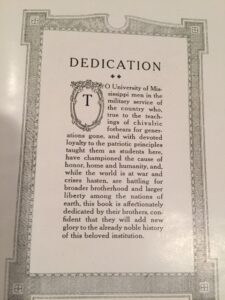Contributors
What Was Happening on the Ole Miss Campus 100 Years Ago

Recently, the General (Jim Stephens) afforded me the opportunity to borrow his 1917-18 Ole Miss Annual. It was fascinating to note that the more things change, the more they stay the same.
The Annual in 1918 was divided into six sections or “books”: The University, The Student Body, Organizations, Athletics, Miscellaneous and the Military.
This was the 22nd Annual published, which in 1918 was the product of 85 seniors. The Annual was dedicated to the University of Mississippi men in the military as WWI was raging. The actual wording in the Dedication stated when referring to these students and alums that they “will add new glory to the already noble history of this beloved institution.”
 Perusing Book I, a winter scene depicting the campus covered in snow was interesting. The Memorial Gateway to the campus provided by the class of 1902 was highlighted. A silhouette of the Confederate Monument was included on each page of this section. Several photos of buildings no longer present, such as Gordon Hall and the Medical Building, was featured while two buildings still prominent on the campus, Ventress Hall (then the Law Building) and Bryant Hall (then the Library), were also highlighted. The photo of The Lyceum in 1917 looked very different from its modern-day restructure of 2017.
Perusing Book I, a winter scene depicting the campus covered in snow was interesting. The Memorial Gateway to the campus provided by the class of 1902 was highlighted. A silhouette of the Confederate Monument was included on each page of this section. Several photos of buildings no longer present, such as Gordon Hall and the Medical Building, was featured while two buildings still prominent on the campus, Ventress Hall (then the Law Building) and Bryant Hall (then the Library), were also highlighted. The photo of The Lyceum in 1917 looked very different from its modern-day restructure of 2017.
Some notable names of 1917 worth mentioning were Governor T.G. Bilbo, Chancellor Joseph Neely Powers, Vice Chancellor Alfred Hume who also served as the Dean of Liberal Arts and Professor of Mathematics. Hume was an 1887 graduate of Vanderbilt. Alexander Lee Bondurant was professor of Latin, Language and Literature. The faculty consisted of 27 members including Dr. Billy S. Guyton who was professor of Pathology and Bacteriology.
 As to Book II, “The Classes” or Student Body reflected 108 seniors and 72 freshmen. The four disciplines of Medical, Law, Engineering and Pharmacy each had subsections.
As to Book II, “The Classes” or Student Body reflected 108 seniors and 72 freshmen. The four disciplines of Medical, Law, Engineering and Pharmacy each had subsections.
Book III “Organizations” referenced the fact that an act of the Legislature in 1912 abolished all fraternities and secret clubs. An editorial emphasized the negative fallout of this decision. As a result of this action and a possible remedy led to the November 1917 plan for an Associated Student Body Organization. Their very first work created an organization to provide a moving picture show on campus. A few clubs/organizations of note were the University Red Cross, the Masonic Club and the Bone Dry Club, described as a “funnel of fun for the sophomores.”
 Book IV “Athletics” showcased the four sports of that era….Football, Basketball, Baseball and Track. Coach C.R. Noble was in his first year. The Annual referenced the fact that most all “M” men were in the military which weakened the sports teams considerably. The 1917 football team went 1-4-1, with lopsided losses to LSU (52-7), Alabama (52-0), Mississippi A&M (41-14) which the narrative described the offense looked promising against the “farmer lads.” The game against A&M (State) was played in Tupelo. On November 10, 1917, Ole Miss lost to Sewanee 69-7 which the Annual labeled “The Mountain Tiger.” (Similarities to 2017 caught my attention as the season opened in 1917 with a scoreless tie to Arkansas Agricultural College. Ole Miss would win its only game that season by defeating MS College 21-0 in Jackson on Thanksgiving.)
Book IV “Athletics” showcased the four sports of that era….Football, Basketball, Baseball and Track. Coach C.R. Noble was in his first year. The Annual referenced the fact that most all “M” men were in the military which weakened the sports teams considerably. The 1917 football team went 1-4-1, with lopsided losses to LSU (52-7), Alabama (52-0), Mississippi A&M (41-14) which the narrative described the offense looked promising against the “farmer lads.” The game against A&M (State) was played in Tupelo. On November 10, 1917, Ole Miss lost to Sewanee 69-7 which the Annual labeled “The Mountain Tiger.” (Similarities to 2017 caught my attention as the season opened in 1917 with a scoreless tie to Arkansas Agricultural College. Ole Miss would win its only game that season by defeating MS College 21-0 in Jackson on Thanksgiving.)
A few other interesting observations of the Ole Miss of 100 years ago included a campus vote for “Prettiest Co-Ed” won by Miss Marvel Ramey. And there were only three cheerleaders that year… all male.
 Steve Vassallo is a HottyToddy.com contributor. Steve writes on Ole Miss athletics, Oxford business, politics and other subjects. He is an Ole Miss grad and former radio announcer for the basketball team. Currently, Steve is a highly successful leader in the real estate business who lives in Oxford with his wife Rosie. You can contact Steve at sovassallo@gmail.com or call him at 985-852-7745.
Steve Vassallo is a HottyToddy.com contributor. Steve writes on Ole Miss athletics, Oxford business, politics and other subjects. He is an Ole Miss grad and former radio announcer for the basketball team. Currently, Steve is a highly successful leader in the real estate business who lives in Oxford with his wife Rosie. You can contact Steve at sovassallo@gmail.com or call him at 985-852-7745.
Follow HottyToddy.com on Instagram, Twitter and Snapchat @hottytoddynews. Like its Facebook page: If You Love Oxford and Ole Miss…

















Loretta
October 30, 2017 at 2:10 pm
Which parts have “stayed the same”?